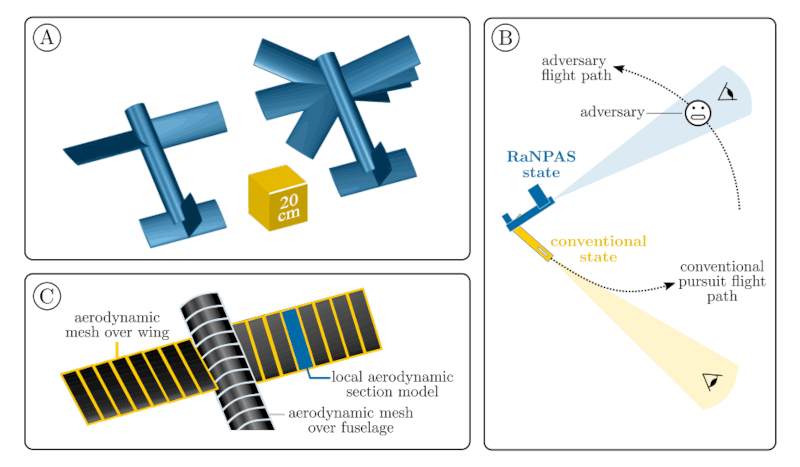One staple of science fiction is the ornithopter, which is a plane with moving wings. While these haven’t proved very practical in the general sense, a recent paper talks about mimicking natural wings changing shape to improve maneuverability in drones and other aircraft. In particular, the paper talks about how the flight performance of many birds and bats far exceeds that of conventional aircraft.
The technical term for being more maneuverable than a conventional aircraft is, unsurprisingly, called supermaneuverability. Aircraft performing things like the Pugachev Cobra maneuver (watch the video below, or the latest Top Gun movie) require this type of operation, and with modern aircraft, this means using thrust-vector technology along with unstable airframes and sophisticated computer control. That’s not how birds or bats operate, though, and the paper uses modern flight simulation techniques to show that biomimicry and thrust vector technology don’t have to be mutually exclusive.
So how do you apply lessons from birds, bats, and even flying squirrels to drones? The answer appears to be in allowing the wings to dynamically change shape or, as the paper calls it, morph.
One key maneuver covered in the paper is especially interesting to military drones: RaNPAS or rapid-nose-pointing-and-shooting. Presumably, you aren’t worried about that for your next drone project, but being able to maneuver more like a bird would be great.
Not that we haven’t seen actual ornithopters around here. Some of them are practically prehistoric.















Wow love that chemtrail :D
Tuns out that most passengers don’t like weird maneuvers while traveling a few thousand kilometers in an airplane. They even start getting worried by a bit of turbulence. I’ve also never seen a bird pull 8G at mach 2.
On top of that, that “cobra” maneuver looks fancy, but it does not seem very suiting for a fighter yet to do low speed shows in front of an eager enemy.
But, euh, what was the subject of this story?
… Turns out that if you follow the first link, there is a second link to a 38 page .pdf about Pitch-axis supermanoeuvrability in a biomimetic morphing-wing aircraft, which looks quite serious, but too serious for light reading.
It’s not about passenger aircraft, is it? (Though I believe there are applications of morphing wings for passenger jets to improve fuel efficiency at different speeds?).
As the article clearly says, it’s about RaNPAS – pointing the nose of the plane at an enemy, presumably because you’ve got guns/canons mounted along the fuselage which – whilst they may have some tracking – need the plane body to be pointed largely in the direction of fire.
Others can say better but I believe the canon has fallen out of favour in fighters, with missiles taking its place? But this might tip it back. Particularly for, say, drone fighters.
It’s also about getting the nose pointed enough for a high-off-boresight IR missile to be able to track.
That said, burning your energy by turning yourself into a kite in a real-world dogfight would definitely be a very last-ditch effort in a modern fight. If there was an adversary within 100 miles in a good energy state, they’d just have to sling a medium-range radar-guided missile at you and you’d never have enough energy to evade it.
We were doing kills with Phoenix missiles @275 + nautical miles back in the 70s
“I’ve also never seen a bird pull 8G at mach 2.”
Pray we never do because they’ll be coming for us.
B^)
The Wright Bros tried wing warping in their early aircraft but it quickly got replaced by the conventional control surfaces we still use today. Probably best left to unmanned flight.
Aircraft structures at that point were so floppy that they got control reversal a lot, where the aerodynamic forces imposed by operating a control surface move the surrounding structure so much you get the opposite control that you requested. Wing warping was better about this than ailerons, but relied/insisted on a flexible wing, and that led to structural failures and put significant limitations on how fast the aircraft could fly before the flexible wing started exhibiting uncontrolled flexing.
We’ve gotten way better at designing anisotropic structures. The X29 is a good example of this, where the design managed spanwise flow and produced a prandtl elliptic lift distribution with forward-swept wings that could not previously be built because of divergent flex.
I believe it was Alexander Graham Bell who first put ailerons on aircraft.
Ailerons were invented as a workaround to the Wright Brothers wing warping patent. The Wright Brothers supposedly used wing warping because it made the airplane structure simpler and lighter, which was a good thing for their not so powerful engine.
You don’t need thrust vectoring to do the cobra (though it helps), famously the flankers (Su-27 and family) have been able to do it without thrust vectoring for a while. It requires a certain amount of instability in the pitch axis (a trait of most modern fighters, though I’m sure there are subtleties that will make certain airframes better suited to the maneuver) and an avionics suite that will allow you to do it.
Wikipedia says that the MiG-21, Saab J-35, Mig-29, Su-27, and Su-57 can do it. I know the F-22 can as well, and I suspect most modern delta-canards are capable of it.
https://www.youtube.com/watch?v=BOCFQfOvzGc
attempting a cobra in a MiG-21 is like playing Russian roulette with an automatic pistol…
Yeah, definitely not a great idea, but the cobra is usually not a great idea in and of itself.
and that’s just getting it off the runway :-D